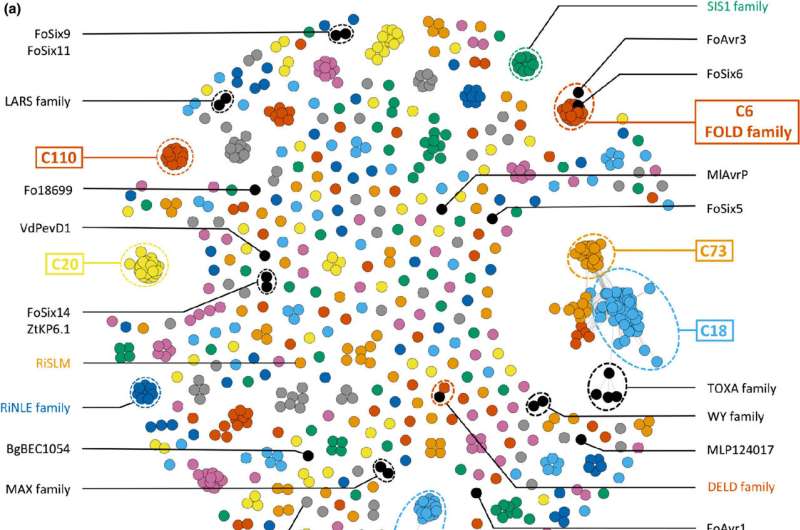This article has been reviewed according to Science X's editorial process and policies. Editors have highlighted the following attributes while ensuring the content's credibility:
fact-checked
peer-reviewed publication
trusted source
proofread
Symbiotic and pathogenic fungi may use similar molecular tools to manipulate plants

Symbiotic and pathogenic fungi that interact with plants are distantly related and don't share many genetic similarities. Comparing plant pathogenic fungi and plant symbiotic fungi, scientists at the Sainsbury Laboratory Cambridge University (SLCU) have discovered that these remote relatives are using a similar group of proteins to manipulate and live within plants.
Sebastian Schornack's research team is working to identify and characterize new arbuscular mycorrhiza (AM) effectors—proteins secreted by symbiotic AM fungi to facilitate colonization of plant roots. As part of this they are also investigating whether pathogenic and symbiotic fungi are using similar or different strategies.
Using the AlphaFold2 AI computer program that predicts protein structures, the team is the first to compare secreted proteins from symbiotic and pathogenic fungi. They found that symbiotic fungi encode the same family of proteins that pathogenic fungi use to interact with and colonize plants. The findings were published today in New Phytologist.
"There is a huge diversity in the genetic code of effector proteins in closely related microbes, so it is even more difficult to compare protein sequences between pathogens and symbionts that are more distantly related," said Dr. Albin Teulet, who is first author of the research.
"Instead, we took advantage of the recent development of AlphaFold2 to do a comparison between the secreted protein structures from a symbiotic fungus and pathogenic fungus. This led to the discovery that there is a group of structurally very similar proteins previously known from pathogens that are also present—often in greater numbers—encoded in the genomes of symbiotic fungi."
Plant-fungi relationships have a dramatic effect on plant health in natural ecosystems and agriculture—both positive and negative. AM fungi are the most common symbiotic association of plants with microbes, colonizing plant roots to promote nutrient uptake, enhance plant growth and even help fend off pathogens.
While pathogenic fungi, such as strains of Fusarium oxysporum, are some of the world's most devastating pathogens with a wide host range and are currently threatening to wipe-out Cavendish banana and oil palm plantations. Fusarium also has lent its name to the group of proteins the team have found: Fusarium oxysporum lycopersici dual-domain proteins (FOLDs).
The researchers classified all the proteins secreted by the symbiotic AM fungus Rhizophagus irregularis and identified a large family of FOLD-like effectors (MycFOLDs) with high structural similarity to the FOLD proteins produced by the Fusarium oxysporum pathogen.
FOLD effectors are only found in the genomes of fungi that form associations with living plants. This suggests that these proteins underpin universal mechanisms enabling both pathogens and symbiotic fungi to live within plants.
Dr. Schornack said discovering that plant symbiotic and pathogenic fungi were using some of the same tools provided a new perspective on our understanding of fungal symbionts: "The apparently exclusive presence of FOLD/MycFOLDs across unrelated plant-colonizing fungi supports the hypothesis that FOLD proteins act as effectors during plant colonization of both symbiotic and pathogenic fungi."
"If symbiotic and pathogenic fungi are using the same tools, this means devising ways to enhance AM relationships in crops might make the crops more susceptible to pathogens at the same time. However, these findings now open new questions for us to explore, such as why do symbiotic fungi have these proteins that pathogens also have and what do they actually do?"
The fundamentals of plant-microbe interactions
Understanding the similarity and diversity of effectors used by symbionts and pathogens is critical to understanding the fundamentals of plant-microbe interactions.
The plant-pathogen relationship has been well studied with many of the effector proteins already known. However, less is known about plant-symbiont interactions, like those between plants and AM fungi.
Plants that form beneficial relationships with symbiotic fungi control all stages of the colonization—they can reject or expel colonizers if they deem the fungal colonization not necessary, such as in soil environments with plentiful supplies of nutrients like phosphate.
However, AM fungi are dependent on plant-produced nutrients and thus also have their own survival strategy, particularly in cases where the relationship is unwanted by the plant.
During the infection process, pathogenic fungi suppress their plant host's immunity by secreting a cocktail of effector proteins. Even though symbiotic fungi are beneficial to plants, they too must communicate with the plant or overcome barriers to successfully colonize plant cells.
Only a small number of effector proteins secreted by symbiotic AM fungi have been identified. The Schornack Team is working to uncover other effectors that play a role in the plant-symbiont relationship.
More information: Albin Teulet et al, A pathogen effector FOLD diversified in symbiotic fungi, New Phytologist (2023). DOI: 10.1111/nph.18996
Journal information: New Phytologist
Provided by University of Cambridge




















